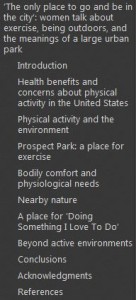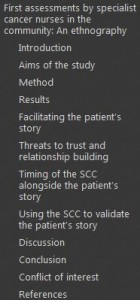Many qualitative researchers operate under different epistemological assumptions … For instance, many qualitative researchers believe that the best way to understand any phenomenon is to view it in its context… to become immersed in it…Be flexible in your inquiry of people in context… allow the questions to emerge and change as you become familiar with what you are studying. Many qualitative researchers also operate under different ontological assumptions about the world. They don’t assume that there is a single unitary reality apart from our perceptions. Since each of us experiences from our own point of view, each of us experiences a different reality. Conducting research without taking this into account violates their fundamental view of the individual. … All that we can hope to do is interpret our view of the world as researchers. (Trochim, The Research Methods Knowledge Base, The Qualitative Debate)
 Qualitative research poses research questions that are best answered by words: data is generated by purposeful observation, open-ended questions, and critical analysis (for more on qualitative methodology, see Trochim, Qualitative Approaches and Qualitative Methods). Results are not typically numerical, but represented through text using categories and explanation. Qualitative research is often employed at the beginning of a new area of study – we have to observe and learn what something is before we can ask measurable questions or plan well-directed experimentation. Qualitative research reports employ both functional headings (especially Introduction and Conclusion) as well as topical headings which organize the results of the research. This is clearly seen in outlines, which begin with the classic “Introduction” expected of all research reports, but in which the body is organized according to content-driven labels which convey the major idea of that data in that section.
Qualitative research poses research questions that are best answered by words: data is generated by purposeful observation, open-ended questions, and critical analysis (for more on qualitative methodology, see Trochim, Qualitative Approaches and Qualitative Methods). Results are not typically numerical, but represented through text using categories and explanation. Qualitative research is often employed at the beginning of a new area of study – we have to observe and learn what something is before we can ask measurable questions or plan well-directed experimentation. Qualitative research reports employ both functional headings (especially Introduction and Conclusion) as well as topical headings which organize the results of the research. This is clearly seen in outlines, which begin with the classic “Introduction” expected of all research reports, but in which the body is organized according to content-driven labels which convey the major idea of that data in that section.
Continuums and Complexities
There is a great deal of variation in how qualitative research reports are constructed. This is both blessing and curse for a new writer. Keep in mind that the reader still needs to know the same kinds of information as any other research report: what happened, why it’s important, and what the outcomes mean for the field.
This variation is grounded in the methods of qualitative studies themselves. All qualitative research aims to collect data whose patterns are better revealed through words and the nuanced meanings that only words can convey. However, qualitative approaches may be figured on a continuum from those resembling classic scientific study to those with immersive designs that place researchers in the middle of the study environment. More characteristically science-y studies usually have more explicit, focused research questions with qualitative methods employed to reveal answers. Studies on the immersive end, often labeled ethnographic research, more frequently start with a “problematic” context where the goal of the research is a new understanding of the environment; to gain access to the environment, researchers more frequently embed themselves in the research context as participant-observers.
The fallout for writing qualitative research is a creative blend of possibilities. All qualitative research reports must have an Introduction that explains the research motivation to the reader; all must have a Discussion or Conclusion that synthesizes the overall contribution of the study. However, the organization and style joining the two ends varies. Broadly speaking, we’ll characterize the writing styles via their extremes, between more classic research reports on the one end and those with more narrative qualities on the other.
 |
 |
 |
 |
Qualitative research includes both functional and topical subheadings; topical subheadings provide short clues about content.